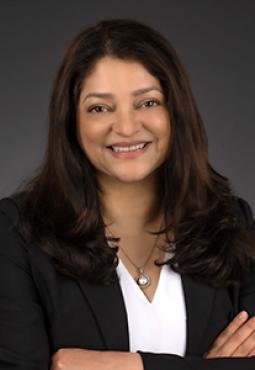Mussoorie, India, is a scenic resort town in the Himalayas where, some time ago, a group of children loved to climb trees and play along the rocky, oak-covered mountains. This, of course, led to plenty of scrapes and bruises, but they received excellent care — from one of their playmates.
“I had this little box with a cross taped on it, where I kept bandages, antibiotic ointment, tincture of iodine, alcohol swabs and gauze from my dad’s first-aid army kit, and I would bandage all my little cousins when they fell,” said Chandana Lall, M.D.

It’s not too surprising, then, that Lall grew up to be a physician. This past July, she was named chair of the Department of Diagnostic Radiology at City of HopeÒ.
She also has a passion for art — her paintings have been shown at galleries — and her love for images attracted her to the field of radiology. Her subspecialty is abdominal imaging, which deals with the myriad diseases within the abdomen and pelvis, and which requires vast collaboration between various medical and surgical subspecialties.
The experience she brings to her position at City of Hope is truly outstanding.
She previously chaired the Department of Radiology at the University of Florida, Jacksonville, and has gained international recognition in her field. She has published some 480 articles and numerous abstracts on cancer imaging in major peer-reviewed journals and at conferences worldwide. For her significant contributions to the radiology field, Lall has received more than 60 awards and recognitions, including being named a fellow of the Society of Abdominal Imaging and earning the honored educator award from the Radiological Society of North America.
She graduated summa cum laude from the University of Delhi, where she earned her medical degree and pursued a radiology residency, followed by a radiology residency and fellowship in abdominal imaging, respectively, at Maimonides Medical Center and Beth Israel Medical Center, both in New York.
She has two children, a daughter in medical school and a son studying international business and entrepreneurship in college. Her husband — the man she fell in love with in medical school — is Robby Gulati, M.D., now associate dean at the University of California Riverside School of Medicine. One reason she was drawn to City of Hope is its approach to diagnostic radiology, which fosters the greatest possible accuracy.
“At City of Hope, we do subspecialized readings. We have people who did their fellowships in a specific area — cardiothoracic imaging, abdominal imaging, breast imaging, interventional radiology and so forth — so we are at the highest level of training to accurately read a scan,” she explained.
No Room for Error
The importance of subspecialized radiology recently hit home for Lall when she got a call from an old friend in India.
“In the past year, she’d suffered from mild abdominal pain and had had several abdominal MRIs, which showed a pancreatic cyst. The radiologist kept reading this as a pseudocyst, a benign lesion that can occur after an episode of pancreatitis,” she said.
'Staging has to be 100% accurate, 100% of the time.'
Chandana Lall, M.D., chair of Diagnostic Radiology
Her friend sent the scans to Lall by courier, and what she saw did not look benign. It appeared to be a mucinous cystic neoplasm of the pancreas, which has a high likelihood of malignancy. An endoscopic ultrasound and fluid analysis confirmed a high presence of tumor markers and atypical cells.
Thanks to Lall’s specialized understanding of what the scan showed, her friend underwent surgery and is doing well.
Correct Staging Is Critical
In addition to making the correct diagnosis, the need for precise staging cannot be understated.
“Imaging is a crucial part of cancer diagnosis, treatment and management, and accuracy is particularly essential with the first read,” Lall said. “Staging has to be 100% accurate, 100% of the time.”
Both understaging and overstaging lead to suboptimal patient care. If a cancer is understaged, it won’t be treated as aggressively as it should be. If it is overstaged, a patient might undergo unnecessary treatment.
Innovative Approaches
Lall has been at the forefront of research in diagnostic radiology. This year, one of her most significant papers was published in the American Journal of Clinical and Experimental Urology. It describes how the early spread of bladder cancer into the draining veins around the bladder can have negative consequences for treatment — a subtle finding that is nonetheless critical for appropriate tumor management.
In another project that may soon benefit City of Hope patients, she is evaluating the use of whole-body magnetic resonance imaging (MRI) for the early detection and staging of gynecological cancers — a modality that would have significant advantages over computed tomography (CT) and positron emission tomography (PET) scans.
“CT and PET scans require a tracer and a great deal of preparation for the patient, but a whole-body MRI can take 20 or 30 minutes, and there’s no radiation,” she said. “We first had to get the sequences correct, but now it’s become a good way to stage.”
She’s also excited about some important new uses of molecular imaging radiology in cancer treatment. The nuclear medicine team is working on state-of-the-art technology that zeroes in on tumor cells and radiates them precisely, while not harming healthy tissue. And the interventional radiology team has just received a substantial grant for a new breakthrough treatment that can deliver immunotherapy directly into lung cancer tumors.
“I look forward to partnering with my colleagues to integrate the most sophisticated imaging technologies into City of Hope’s clinical trials and cancer therapies," Lall said. "Advanced imaging techniques have revolutionized health care, playing a crucial role in improving outcomes, from the evaluation of new treatments to increasing efficiencies in patient care while reducing costs. My overarching goal is to advance the organization’s leadership in imaging innovation, patient care and educational excellence.”
Reaching Out to the Underserved
Growing up in the Himalayas, Lall lived in an area with good schools and good doctors — but there are many remote villages in those mountains and in other parts of the world where people have little or no access to modern medical care.
She would like to bring inexpensive ultrasound equipment to these areas and train appropriate local people to use it. They would be taught to recognize certain acute emergencies in the abdomen — pleural effusion, pericardial effusion, appendicitis and hydronephrosis, to name a few. They could then transmit an image to a radiologist, who would diagnose the scan.
“If the condition is serious, the patient could be airlifted to a city, and that would save lives,” she said.
